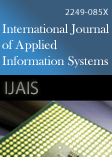
- K. Seetharaman and R. Ragupathy 2012. A Novel Biometric Cryptosystem using LDPC and SHA based Iris Recognition. International Journal of Applied Information Systems. 4, 1 (September 2012), 41-47. DOI=http://dx.doi.org/10.5120/ijais450632
-
@article{10.5120/ijais2017451568, author = {K. Seetharaman and R. Ragupathy}, title = {A Novel Biometric Cryptosystem using LDPC and SHA based Iris Recognition}, journal = {International Journal of Applied Information Systems}, issue_date = {September 2012}, volume = {4}, number = {}, month = {September}, year = {2012}, issn = {}, pages = {41-47}, numpages = {}, url = {/archives/volume4/number1/267-0632}, doi = { 10.5120/ijais12-450632}, publisher = { xA9 2010 by IJAIS Journal}, address = {} } -
%1 450632 %A K. Seetharaman %A R. Ragupathy %T A Novel Biometric Cryptosystem using LDPC and SHA based Iris Recognition %J International Journal of Applied Information Systems %@ %V 4 %N %P 41-47 %D 2012 %I xA9 2010 by IJAIS Journal
Abstract
We use Low Density Parity Check (LDPC) error correction code to solve fuzziness i. e. , the variability and noise in iris code generated from Iris Recognition System (IRS) and Secure Hash Algorithm (SHA-512) to transform unique iris code into hash string to make them as a Cancellable Biometric. SHA-512 hash string is used as a key for 512 bits Advanced Encryption Standard (AES) encryption process. In the decryption process, Hash comparison is made between new hash generated by SHA-512 from error corrected iris code and hash stored in smart card. If authentic, 512 bits AES decryption is accomplished. Experiments indicate that, use of LDPC code results in better separation between genuine and impostor users which improves the performance of this novel cryptosystem. Security of this system is very high, which is 2256 under birthday attack. AES algorithm is enhanced by using 512 bits key andincreasingthe number of rounds.
References
- J. Daugman and C. Downing , "Epigenetic randomness, complexity, and singularity of human iris patterns", Proc. of the Royal Society, Biological Sciences, pp. 1737 – 1740, 2001.
- Ajay Kumar, Arun Passi, "Comparison and combination of iris matchers for reliable personal authentication", Pattern Recognition, vol. 43, pp. 1016–1026, 2010.
- S. Sanderson, J. Erbetta, "Authentication for secure environments based on iris scanning technology", IEE Colloquium on Visual Biometrics, 2000
- Y. Sutcu, S. Rane, J. S. Yedidia, S. C. Draper, A. Vetro, "Feature Extraction for a Slepian-Wolf Biometric System using LDPC Codes", IEEE International Symposium on Information Theory (ISIT), pp. 2297- 2301, July 2008.
- A. Nagar, S. Rane, A. Vetro, "Privacy and Security of Features Extracted from Minutiae Aggregates", IEEE International Conference on Acoustics Speech and Signal Processing (ICASSP), pp. 1826-1829, March 2010.
- X. Wu, N. Qi, K. Wang, D. Zhang, "A Novel Cryptosystem Based on Iris Key Generation", Fourth International Conference on Natural Computation (ICNC), vol. 4, pp. 53-56, October 2008.
- X. Wu, K. Wang, D. Zhang, "A Cryptosystem Based on Palmprint Feature", 19th International Conference on Pattern Recognition (ICPR), pp. 1-4, December 2008.
- J. Daugman, "Biometric personal identification system based on iris analysis", Patent no. 5291560, 1994.
- K. Seetharaman, R. Ragupathy, "Iris Recognition for Personal Identification System", Procedia Engineering, Elsevier, Accepted, 2012.
- Chinese Academy of Sciences' Institute of Automation (CASIA), Iris image database CASIA-Iris-V3, Available online: http://www. cbsr. ia. ac. cn/IrisDatabase. htm.
- National Institute of Standards and Technology, "Secure hash standard", Federal Information Processing Standards Publications FIPS PUB 180, May. 1993.
- National Institute of Standards and Technology, "Secure hash standard", Federal Information Processing Standards Publications FIPS PUB 180-1, 1995.
- National Institute of Standards and Technology, "Secure hash standard", Federal Information Processing Standards Publications FIPS PUB 180-2, 2001.
- National Institute of Standards and Technology, "Advanced Encryption Standard", Federal Information Processing Standards Publications FIPS PUB 197, pp. 1-51, November 2001.
- J. Daemen and V. Rijmen, "The Design of Rijndael: AES - The Advanced Encryption Standard", Springer-Verlag, Berlin Heidelberg, 2002.
- J. Daemen and V. Rijmen, "The Block Cipher Rijndael", Lecture Notes in Computer Science, vol. 1820, pp. 277-284, Berlin: Springer-Verlag, 2000.
- E. Biham, O. Dunkelman, and N. Keller, "Related-Key Boomerang and Rectangle Attacks", Lecture Notes in Computer Science, vol. 3494, pp. 507-525, Berlin: Springer-Verlag, 2005.
- N. Ferguson, J. Kelsey, S. Luckset al. "Improved cryptanalysis of Rijndael", Lecture Notes in Computer Science, vol. 1978, pp. 213-230, Berlin:Springer-Verlag, 2001.
- Mohammed A. M. Abdullah, F. H. A. Al-Dulaimi, Waleed Al-Nuaimy, Ali Al-Ataby, "Smart card with iris recognition for high security access environment", IEEE, pp. 382-385, 2010.
Keywords
Error Correction Code, Low Density Parity Check, Secure Hash Algorithm, Advanced Encryption Standard, Iris Recognition System
 10.5120/ijais12-450632
10.5120/ijais12-450632
